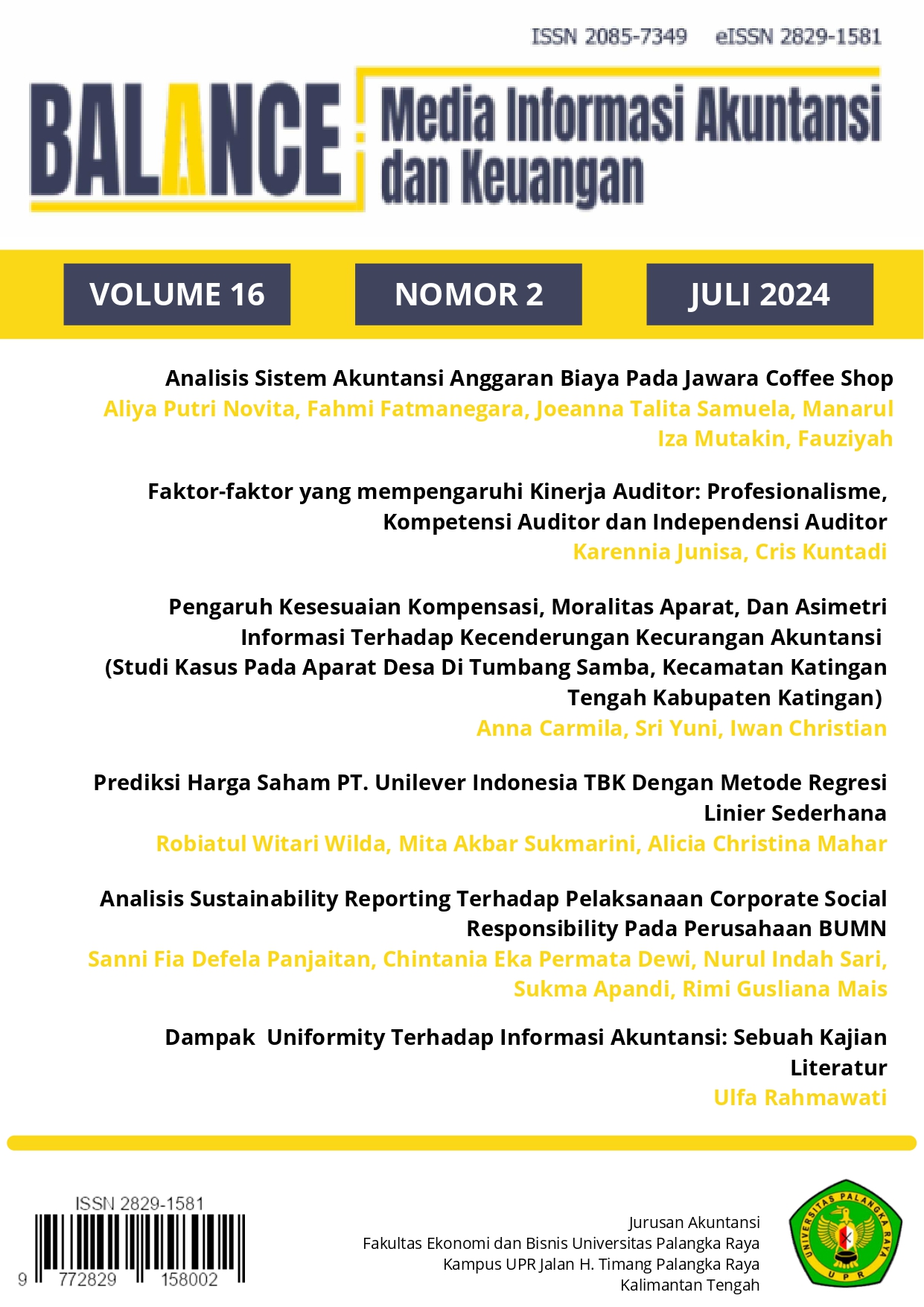Dampak Uniformity Terhadap Informasi Akuntansi: Sebuah Kajian Literatur
DOI:
https://doi.org/10.52300/blnc.v16i2.14647Keywords:
Accounting Theory, Uniformity, Accounting InformationAbstract
Along with the development of the world economy, accounting also continues to develop. The accounting evolution process cannot be separated from public criticism and suggestions. One of these criticisms is uniformity. Uniformity is the level of similarity in financial reporting of companies within a country and even between countries in the world. This research seeks to examine the impact of uniformity on accounting information by conducting a review of previous literature. The results of the study show that uniformity will create comparability of financial reports so that financial reports become relevant and faithful representation and will make it easier for users to make decisions.
Downloads
References
Cadenhead, Garry. 1970. “Difference in Circumstances: Fact or Fantasy?” A Journal of Accounting, Finance, and Business Studies 7, no. 1 (September): 71-80.
Cole, Vicky, Joel Branson, dan Diane Breesch. 2012. “The Uniformity-Flexibility Dilemma When Comparing Financial Statements: Views of Auditor, Analiysts, and Other Users.” International Journal of Accounting and Information Management 20, no. 2: 114-141.
Estes, Ralph, dan Homer A Brown Jr. 1966. “Comparability and Flexibility: Proposed Solution to the Uniformity Dilemma.” Financial Analysts Journal 22, no. 3 (May-June): 65-68.
Graham, Willard J. 1965. “Some Observations on the Nature of Income, Generally Accepted Accounting Principles, and Financial Reporting.” Law and Contemporary Problems 30, no. 4 (Autumn): 652-673.
Gray, S.J. 1988. “Toward a Theory of Cultural Influence on the Development of Accounting Systems Internationally.” A Journal of Accounting, Finance, and Business Studies 24, no. 1: 1-15.
Hahn, Rüdiger, danMichael Kühnen. 2013. “Determinants of Sustainability Reporting: A Review of Results, Trends, Theory, and Opportunities in an Expanding Field of Research.” Journal of Cleaner Production 59: 5–21. https://doi.org/10.1016/j.jclepro.2013.07.005.
Hann, Rebecca N, Yvonne Y Lu, dan K. R Subramanyam. 2007 . “Uniformity versus Flexibility: Evidence from Pricing of the Pension Obligation.” The Accounting Review 82, no. 1 (Januari): 107-137.
Hendriksen, Eldon S. 1967. “ Toward Greater Comparability through Uniformity of Accounting Principles.” CPA Journal, (February): 105-115.
Holdren, George C. 1963. “Toward Greater Comparability of Financial Statement.” Financial Analysts Journal 19, no.2 (March-April): 101-104.
Jones, Rowan, dan Maurice Pendlebury. 2012. “Uniformity v. Flexibility in the Published Accounts of Local Authorities: the UK Problem and Some European Solution.” Accounting and Business Research 12, no.46: 129-135.
Keslar, Linda. 1994. “US: Creating Uneven Playing Field?” Dalam Reading and Notes on Financial Accounting, oleh Zeff, Stephen A, dan Dharan, Bala G 28-35. Singapore: McGraw-Hill Book Co.
Littleton, A.C, dan V.K Zimmerman. 1962. Accounting Theory: Continuity and Change. The United States of America: Prentice-Hall Inc.
Milburn, Alex, dan Ian. Hague 1997. “A Need for Uniformity.” CA Magazine 130, no. 3: 45-47.
Mueller, Gerhard G. 1965. “International Experience with Uniform Accounting.” Law and Contemporary Problems 30, no. 4 (Autumn): 850-873.
Paton, W.A, dan A.C Littleton. 1970. An Introduction to Corporate Accounting Standards. The United States of America: American Accounting Association.
Peloubet, Maurice. 1986. “ Is Further Uniformity Desirable or Posible?” Journal of Accountancy (April): 35-41.
Powell, Weldon. 1965. “Putting Uniformity in Financial Accounting into Perspective.” Law and Contemporary Problems 30, no.4 (Autumn): 674-689.
Price, Jay H, Jr Richard Walker, dan Leonard Spacek. 1965. “Accounting Uniformity in the Regulated Industries.” Law and Contemporary Problems 30, no.4 (Autumn): 824-849.
Radig, William J, dan Brian Loudermilk. 1998. “Leading the Way to Uniform Accounting Principles.” Review of Business 19, no.3 (Spring): 22-26.
Roberts, Clare B, dan Stephen B Salter. 1999. “Attitude Towards Uniform Accounting: Cultural or Economic Phenomena?” Journal of International Financial Management and Accounting 10, no.2: 121-142.
Sprouse, Robert. 1978. “The Importance of Earnings in the Conceptual Framework.” Journal of Accountancy, 64-71.
Stans, Maurice H. 1949. “Weakness in Present Accounting which Inhibit Understanding of Free Enterprise.” Journal of Accountancy (December): 466-471.
Financial Accounting Standards Board. 2010. Statement of Financial Accounting Concepts No. 8. The United States of America: Financial Accounting Foundation.
Wahono, Romi Satria. 2015. “A Systematic Literature Review of Software Defect Prediction: Research Trends, Datasets, Methods and Frameworks.” Journal of Software Engineering1 (1): 1–16.
Wolk, Harry I, James L Dodd, dan John J Rozycki. 2013. Accounting Theory. United States of America: SAGE Publications Inc.
Zaid, Omar Abdullah. 2000. “Were Islamic Records Precursors to Accounting Books Based on the Italian Method?” The Accounting Historians Journal 27, no. 1 (June): 73-90.
Downloads
Published
How to Cite
Issue
Section
License
Copyright (c) 2024 Balance: Media Informasi Akuntansi dan Keuangan

This work is licensed under a Creative Commons Attribution 4.0 International License.












